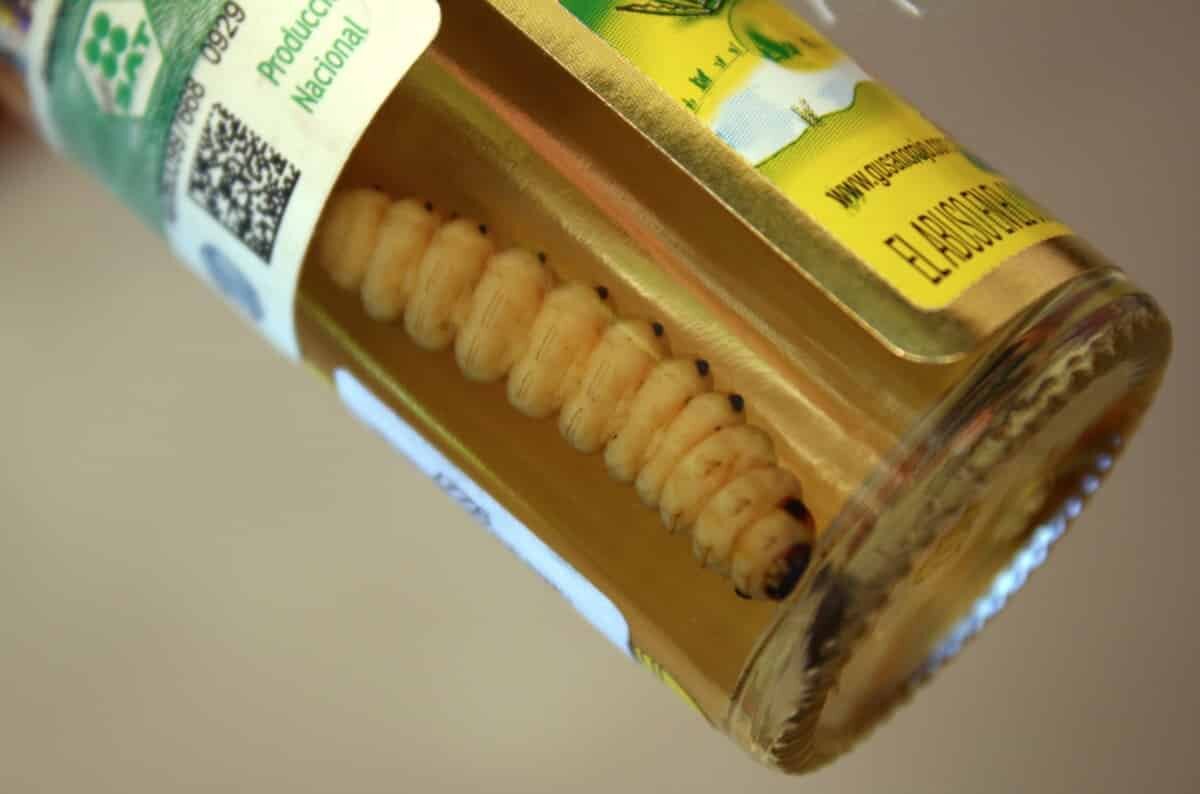
Tequila is a popular distilled spirit made from the blue agave plant in Mexico. It is known for its distinctive taste and is often served with lime and salt. However, some bottles of tequila contain a worm, which can be a source of confusion for many consumers. So why is there a worm in some tequila bottles?
Table of Contents
The History of Tequila
Tequila is a distilled alcoholic beverage made from the blue agave plant, primarily in the area surrounding the city of Tequila and in the Jaliscan Highlands of the central western Mexican state of Jalisco.
The production of tequila dates back to the 16th century, when the Spanish conquistadors arrived in Mexico. Tequila was originally called “mezcal wine,” and it was made from the fermented juice of the agave plant. The name “tequila” was first used in the late 1800s, and it was derived from the name of the town where the drink was first produced.
In the early 20th century, tequila became more popular, and the production process was refined. In 1947, the Mexican government established strict regulations on the production of tequila, including the requirement that it can only be made in certain regions of Mexico.
Today, tequila is one of Mexico’s most popular exports, and it is enjoyed around the world. The drink is often associated with celebrations and parties, and it is commonly consumed as a shot or mixed into cocktails.
 photo credit: images.squarespace-cdn.com
photo credit: images.squarespace-cdn.com
Why Worms are Associated with Tequila
Contrary to popular belief, the worm is not actually found in tequila but in a similar drink called mezcal. Mezcal is also made from the agave plant, but it is produced in a different way and in different regions of Mexico. The worm, which is actually the larval stage of a moth, is added to some bottles of mezcal as a marketing gimmick. However, not all bottles of mezcal contain a worm, and it is not a traditional part of the drink.
While many people associate tequila with a worm, the truth is that worms are not typically found in tequila bottles. Instead, they are more commonly found in mezcal bottles.
Mezcal is another distilled spirit made from the agave plant, but it is produced in different regions of Mexico using different types of agave. The inclusion of a worm in mezcal bottles is primarily a marketing gimmick that dates back to the 1950s.
According to Sound Brewery, the worm was first added to mezcal bottles by a young entrepreneur named Jacobo Lozano Páez, who claimed that the worm made the mezcal taste better. However, the truth is that the worm is primarily included for shock value and marketing purposes.
The worm itself is actually the larval stage of a moth, known as Hypopta agavis. The moth lays its eggs in the agave plant, and when the larvae hatch, they feed on the plant’s sugars. The larvae are then harvested, toasted, and added to mezcal bottles.
Despite the fact that worms are not typically found in tequila bottles, many people still associate them with the spirit. This is likely due to the fact that tequila and mezcal are both made from the agave plant and are both produced in Mexico. However, it is important to note that the inclusion of a worm is not a traditional practice in tequila production.
The Worm as a Marketing Strategy
The tradition of adding a worm to tequila or mezcal bottles is believed to have started as a marketing strategy to differentiate brands and capture consumers’ attention. The worm, also known as a gusano, is actually the larvae of a moth that infests agave plants. It is typically added to mezcal bottles, not tequila, as mezcal is made from a different type of agave plant.
One of the earliest known instances of adding a worm to mezcal bottles was in the 1940s by a mezcal entrepreneur named Jacobo Lozano Páez. According to VinePair, Lozano added the worm as a marketing ploy to get people to drink more mezcal. He believed that the worm would make his product stand out and create a memorable brand identity. The strategy worked, and soon other mezcal makers started adding worms to their bottles.
Adding a worm to a bottle of mezcal also served as a quality indicator. In the early days of mezcal production, the worm was thought to signify that the mezcal was of high quality and had been properly distilled. However, this belief is not entirely accurate, as the presence of a worm does not necessarily indicate high quality.
Today, adding a worm to a bottle of mezcal is not as common as it once was. Many brands have moved away from the practice, and some countries have even banned the sale of mezcal with a worm. However, some consumers still associate the worm with high-quality mezcal and continue to seek out bottles with the added feature.
Myths and Misconceptions About the Worm in Tequila
There are many myths and misconceptions surrounding the worm in tequila. Here are a few of the most common ones:
- The worm is a sign of high quality: This is not true. In fact, the worm is not even found in tequila but rather in mezcal. While some people believe that the worm is a sign of high quality, this is simply a marketing ploy used by some mezcal producers to make their product stand out.
- The worm is added for flavor: This is also not true. The worm has no flavor and is added purely for visual effect.
- The worm is a hallucinogen: This is a popular myth, but it is not true. While some people believe that the worm has hallucinogenic properties, this is simply not the case. The worm is actually a type of caterpillar that feeds on the agave plant, and is added to mezcal as a marketing gimmick.
- The worm is poisonous: This is not true. While the worm is not poisonous, it is not recommended to eat it. The worm is usually removed before drinking the mezcal, and is not intended to be consumed.
The Impact on the Tequila Industry
The addition of a worm to tequila bottles has had a significant impact on the tequila industry. The tradition of including a worm in a bottle of mezcal was originally a marketing ploy to differentiate mezcal from tequila in the US market in the 1950s. However, the practice has now become synonymous with mezcal and is seen as a unique selling point for some brands.
The inclusion of a worm in a bottle of mezcal has also led to a rise in popularity of the drink in some circles. Some people see the worm as a novelty and enjoy the experience of drinking mezcal with a worm in the bottle. Others believe that the worm has hallucinogenic properties, although this is not true.
However, not all mezcal producers include a worm in their bottles. In fact, some producers see the practice as a gimmick and prefer to focus on the quality of their product instead. Additionally, the use of a worm in a bottle of mezcal has led to some controversy, with some people arguing that it is cruel to include a living creature in a bottle of alcohol.
Despite the controversy, the tradition of including a worm in a bottle of mezcal is likely to continue for some time. It has become a unique selling point for some brands and a novelty for drinkers. However, it is important to note that the worm does not have any special properties and is simply a marketing ploy.
The Worm in Other Alcoholic Beverages
While the worm in tequila is the most well-known example of an insect in an alcoholic beverage, it is not the only one. In fact, the practice of including insects in alcohol has a long history in many cultures around the world.
For example, in China, there is a type of liquor called “baijiu” that is sometimes made with a type of moth larva called a “bamboo worm.” The larvae are added to the liquor during the fermentation process and are said to add a unique flavor to the drink.
Similarly, in Korea, there is a type of rice wine called “maggot wine” that is made by adding maggots to the rice during the fermentation process. The maggots are said to help break down the rice and add a sweet, nutty flavor to the wine.
In Mexico, there is also a type of mezcal called “mezcal con gusano” that is made with a worm, similar to the tequila worm. However, unlike the tequila worm, the mezcal worm is actually edible and is often eaten as a snack or used to flavor dishes.
Frequently Asked Questions
What is the purpose of the worm in mezcal bottles?
The worm in mezcal bottles is actually a caterpillar, not a worm. It is called “gusano” in Spanish. The original purpose of the gusano was to signify the quality of the mezcal. A high-quality mezcal would have a live gusano in the bottle, indicating that the alcohol content was high enough to preserve the worm. However, this practice is no longer used as a measure of quality.
Can you eat the agave worm found in mezcal bottles?
Yes, you can eat the agave worm found in mezcal bottles. However, it is not a requirement, and some people prefer not to eat it. The worm has a slightly nutty flavor and a crunchy texture. Eating the worm is more of a tradition than a requirement.
What is the difference between mezcal and tequila?
Mezcal and tequila are both made from the agave plant, but they are produced differently. Mezcal can be made from any type of agave plant, while tequila can only be made from blue agave. Mezcal is also produced using traditional methods, including cooking the agave in underground pits, while tequila is usually cooked in above-ground ovens. Mezcal has a smokier flavor than tequila.
Does drinking the agave worm in mezcal have any effects?
No, drinking the agave worm in mezcal does not have any effects. Contrary to popular belief, the gusano is not hallucinogenic. It is simply a traditional addition to the mezcal bottle.
Is it illegal to include a worm in mezcal bottles?
No, it is not illegal to include a worm in mezcal bottles. However, it is not a requirement, and some brands choose not to include it. The use of the gusano is more of a tradition than a requirement, and it is up to individual brands to decide whether or not to include it.
Conclusion
The worm in tequila bottles is not a traditional practice. It is primarily associated with mezcal, a distilled alcoholic beverage similar to tequila but produced in specific regions of Mexico using different types of agave. The worm itself is actually the larval stage of a moth, known as Hypopta agavis.
The worm in tequila bottles is a myth that has been perpetuated by marketing tactics. It has no real significance and does not affect the quality or taste of the product.
Related Posts
Here are some related posts that might interest you:
- 7 Questions for Rens Defrenne from The Nectar: In this interview, Rens Defrenne shares his passion for spirits and his journey as a spirits distributor.
- Old-Style VS Modern: was whisky “better back then”?: This article explores the debate about whether whisky was better in the past or if modern whiskies are just as good.
- Where to enjoy a good dram in Malta?: If you’re planning a trip to Malta and want to know where to enjoy a good dram, this post is for you.
- 7 Questions for Craft Beer Revolution Festival’s founder (EXCLUSIVE GIVEAWAY): While this post is mostly about craft beer, it includes an interview with the founder of a craft beer festival and an exclusive giveaway.
- Why I Don’t Rate The Whiskies I Review: In this post, the author explains why she chooses not to rate the whiskies she reviews.



